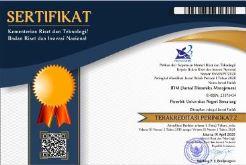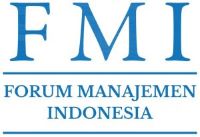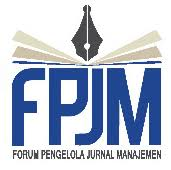Model Technology to Performance Chain (TPC) in Implementing Accrual-Based Sistem Informasi Manajemen Daerah (SIMDA) Finance: Empirical Evidence from Local Government of Indonesia
Abstract
Keywords
Full Text:
PDFReferences
Asrori. 2011. Penggunaan Sistem Informasi Penilaian Kinerja Dosen dan Akuntabilitas Kinerja Dosen. Jurnal Dinamika Manajemen. 2 (2): 162-168.
Aljukhadar, M., Senecal, S & Nantel, J. 2014. Is More Always Better? Investigating the Task-Technology Fit Theory in an Online User Context. Information and Management. 51 (2): 391-397.
Baroudi, J. J., Olson, M. H & Ives, D. 1986. An Empirical Study of the Impact of User Involvement on System Usage and Information Satisfaction. Communications of the ACM. 29 (3): 232-238.
Barratt, M. 2004. Understanding the Meaning of Collaboration in the Supply Chain. Supply Chain Management. 9 (1): 30-42.
Chang, H. H., Tsai, Y. C & Hsu, C. H. 2013. Eâ€procurement and Supply Chain Performance. Supply Chain Management. 18 (1): 34-51.
D’Ambra, J & Wilson, C. S. 2004. Explaining Perceived Performance of the World Wideweb: Uncertainty and the Task-Technology Fit Model. Internet Research Volume. 14 (4): 294-310.
D’Ambra, J., Wilson, C. S & Akter, S. 2013. Application of the Task-Technology Fit Modelto Structure and Evaluate the Adoption of E-Books by Academics. Journal of the American Society for Information Science and Technology. 64 (1): 48-64.
Delone, W. H & McLean, E. R. 2003. The DeLone and McLean Model of Information Systems Success: a Ten-Year Update. Journal of Management Information Systems. 19 (4):9-30.
Goodhue, D. L & Thompson, R. L. 1995. Task-Technology Fit and Individual Performance. MIS Quarterly. 19(2): 213-236.
Goodhue, D. L. 1998. Development and Measurement Validity of Task-Technology Fit Instrument for User Evaluations of Information System. Decision Sciences. 29 (1): 105-138.
Hackman, J. R & Oldham, G. R. 1975. Development of the Job Diagnostic Survey. Journal of Applied Psychology. 60 (2): 159-170.
Hartwick, J & Barki, H. 1994. Explaining the Role of User Participation in Information System Use. Management Science. 40 (4): 440-465.
Huo, B., Ye, Y., Zhao, X & Shou, Y. 2016. The Impact of Human Capital on Supply Chain Integration and Competitive Performance. International Journal of Production Economics. 178: 132-143.
Igbaria, M., Parasuraman, S & Badaway, M. K. 1994. Work Experience, Job Involvement, and Quality of Work Life Among Information Systems Personnel. MIS Quarterly :175-201.
Jogiyanto, H. M. 2007. SI Keperilakuan. Yogyakarta: Andi Offset
Jogiyanto, H. M & Abdillah, W. 2009. Konsep dan Aplikasi PLS (Partial Least Square) Untuk Penelitian Empiris. Yogyakarta: BPFE UGM.
Larsen, T. J., Sørebø, A. M & Sørebø, Ø. 2009. The Role of Task-Technology Fit as Users’ Motivation to Continue Information System Use. Computers in Human Behavior. 25 (3): 778–784.
Liao, S. H., Hu, D. C & Ding, L. W. 2017. Assessing the Influence of Supply Chain Collaboration Value Innovation, Supply Chain Capability and Competitive Advantage in Taiwan’s Networking Communication Industry. International Journal of Production Economics. 191: 143-153.
Lin, T. C & Huang, C. C. 2008. Understanding Knowledge Management System Usage Antecedents: an Integration of Social Cognitive Theory and Task Technology Fit. Information and Management. 45 (6): 410-417.
Lu, H. P & Yang, Y. W. 2014. Toward an Understanding of the Behavioral Intention to Use a Social Networking Site: Anextensionof Task-Technology Fit Tosocial-Technology Fit. Computers in Human Behavior. 34: 323-332.
McGill, T. J & Klobas, J. E. 2009. A Task-Technology Fit View of Learning Management System Impact. Computers and Education. 52 (2): 496-508.
Montazemi, A. R., Cameron, D. A & Gupta, K. M. 1996. An Empirical Study of Factors Affecting Software Package Selection. Journal of Management Information System. 13 (1): 89-105.
Maulina, C. 2015. Pengaruh Karakteristik Tugas, TI dan Individu terhadap Task-Techonolgy Fit (TTF), Utilisasi dan Kinerja. Jurnal Ilmu Sosial dan Ilmu Politik. 4 (1).
Oliveira, T., Faria, M., Thomas, M. A & Popovic, A. 2014. Extending the Understanding Ofmobile Banking Adoption: When UTAUT Meets TTF and ITM. International Journal of Information Management. 34 (5): 689-703.
Parkes, A. 2013. The Effect of Task-Individual-Technology Fit on User Attitude and Performance: an Experimental Investigation. Decision Support Systems. 54 (2): 997-1009.
Puschmann, T & Alt, R. 2005. Successful Use of Eâ€Procurement in Supply Chains. Supply Chain Management. 10 (2): 122-133.
Sundram, V. P. K., Chandran, V. G. R & Bhatti, M. A. 2016. Supply Chain Practices and Performance: the Indirect Effects of Supply Chain Integration. Benchmarking. 23 (6): 1445-1471.
Staples, D. S & Seddon. 2004. Testing the Technology-to-Performance Chain Model. Journal of Organizational and End User Computing. 16 (4): 17-35
Stettheimer, T. D & Ana D. C. 1998. Modeling Utilization of Planned Information Technology. American Medical Informatics Association: 290-294.
Susanti, V. A. 2006. Teknologi Tugas yang Fit dan Kinerja Individual. Jurnal Akuntansi dan Keuangan. 8 (1): 24-34.
Zaman, K. A. U & Ahsan, A. M. M. N. 2014. Lean Supply Chain Performance Measurement. International Journal of Productivity and Performance Management. 63 (5): 588-612.
Zhou, T., Lu, Y & Wang, B. 2010. Integrating TTF and UTAUT to Explain Mobile Bankinguser Adoption. Computers in Human Behavior. 26 (4): 760-767.
View Counter: Abstract - 1707 and PDF - 1123
Refbacks
- There are currently no refbacks.





